Analysis of Coca Cola's Labor Laws and HR Policies Report
VerifiedAdded on 2019/10/31
|5
|1016
|183
Report
AI Summary
This report examines Coca Cola's employment policies and labor laws, focusing on their effectiveness in promoting a diverse workforce. It outlines the company's hiring, selection, and retention processes, detailing the steps involved in identifying vacancies, developing job descriptions, and implementing recruitment plans. The report analyzes the legal framework governing Coca Cola's employment practices, including the Civil Rights Act of 1964 and the Equal Pay Act, highlighting their implications and potential consequences of non-compliance. It also addresses challenges in managing temporary workers and discusses relevant laws like the Fair Labor Standards Act. The report concludes by assessing the effectiveness of Coca Cola's HR policies in promoting diversity, emphasizing strategies like quotas for board representation and preferential hiring practices for women and minority groups, reinforcing the company's affirmative action plan.
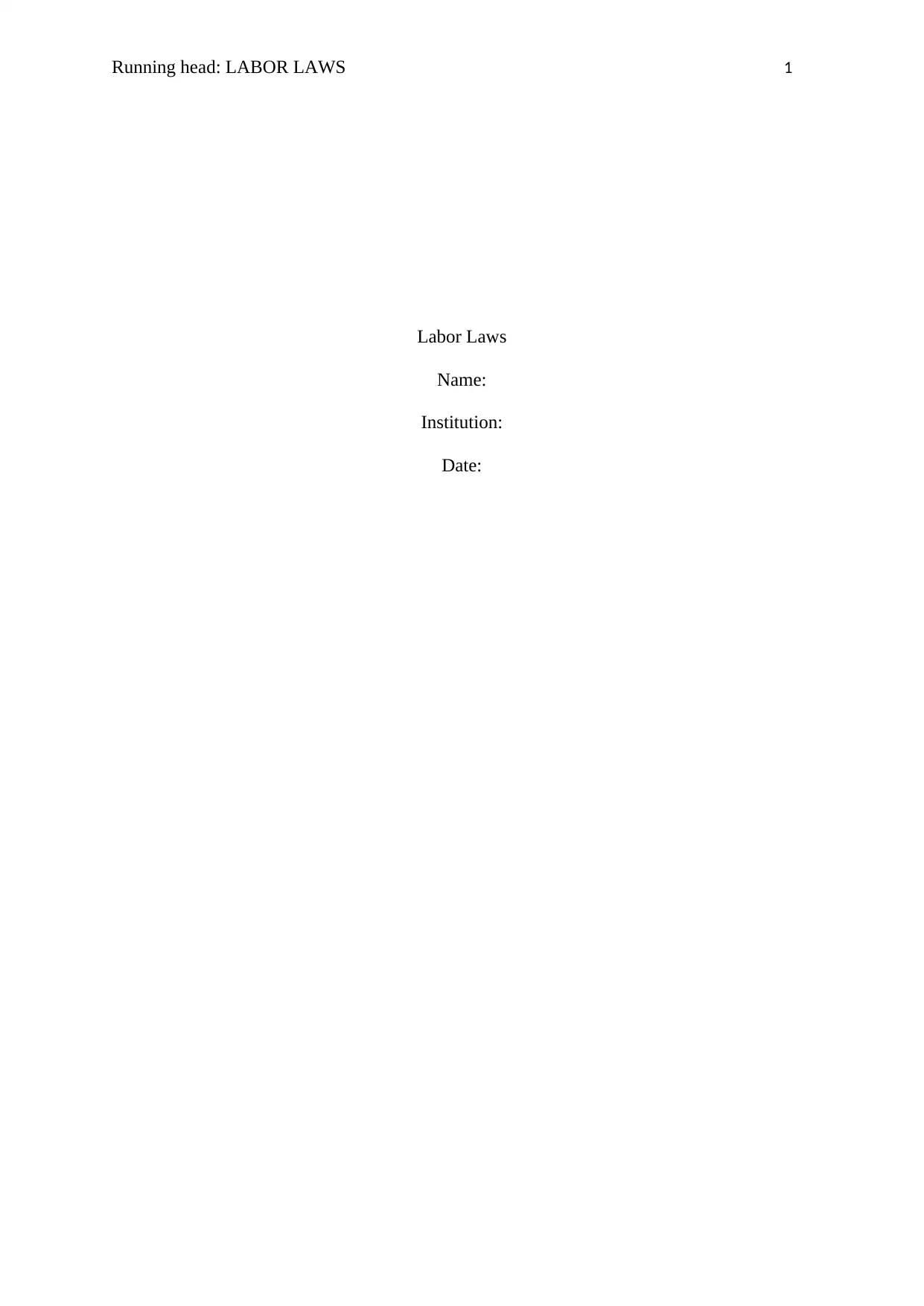
Running head: LABOR LAWS 1
Labor Laws
Name:
Institution:
Date:
Labor Laws
Name:
Institution:
Date:
Paraphrase This Document
Need a fresh take? Get an instant paraphrase of this document with our AI Paraphraser
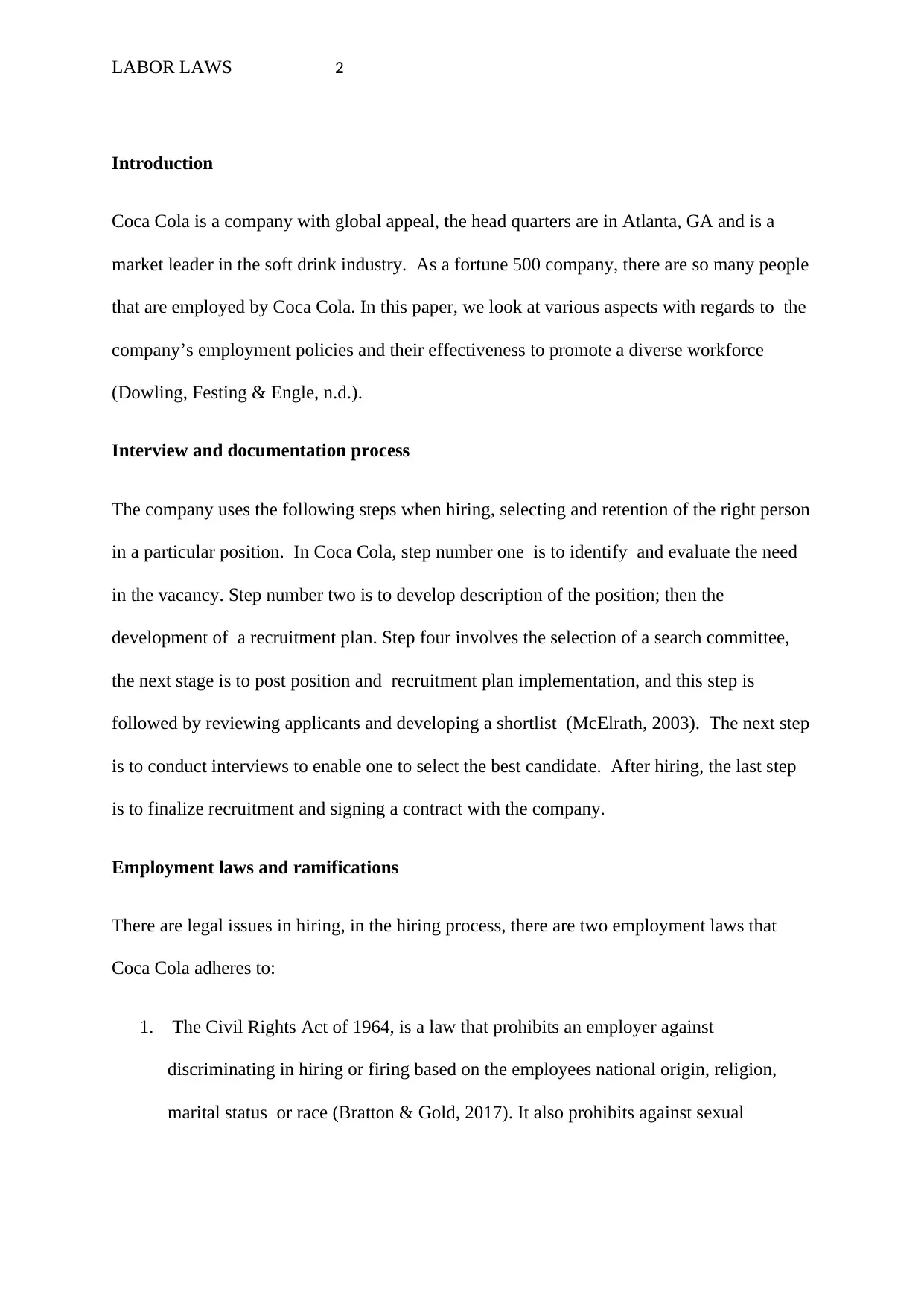
LABOR LAWS 2
Introduction
Coca Cola is a company with global appeal, the head quarters are in Atlanta, GA and is a
market leader in the soft drink industry. As a fortune 500 company, there are so many people
that are employed by Coca Cola. In this paper, we look at various aspects with regards to the
company’s employment policies and their effectiveness to promote a diverse workforce
(Dowling, Festing & Engle, n.d.).
Interview and documentation process
The company uses the following steps when hiring, selecting and retention of the right person
in a particular position. In Coca Cola, step number one is to identify and evaluate the need
in the vacancy. Step number two is to develop description of the position; then the
development of a recruitment plan. Step four involves the selection of a search committee,
the next stage is to post position and recruitment plan implementation, and this step is
followed by reviewing applicants and developing a shortlist (McElrath, 2003). The next step
is to conduct interviews to enable one to select the best candidate. After hiring, the last step
is to finalize recruitment and signing a contract with the company.
Employment laws and ramifications
There are legal issues in hiring, in the hiring process, there are two employment laws that
Coca Cola adheres to:
1. The Civil Rights Act of 1964, is a law that prohibits an employer against
discriminating in hiring or firing based on the employees national origin, religion,
marital status or race (Bratton & Gold, 2017). It also prohibits against sexual
Introduction
Coca Cola is a company with global appeal, the head quarters are in Atlanta, GA and is a
market leader in the soft drink industry. As a fortune 500 company, there are so many people
that are employed by Coca Cola. In this paper, we look at various aspects with regards to the
company’s employment policies and their effectiveness to promote a diverse workforce
(Dowling, Festing & Engle, n.d.).
Interview and documentation process
The company uses the following steps when hiring, selecting and retention of the right person
in a particular position. In Coca Cola, step number one is to identify and evaluate the need
in the vacancy. Step number two is to develop description of the position; then the
development of a recruitment plan. Step four involves the selection of a search committee,
the next stage is to post position and recruitment plan implementation, and this step is
followed by reviewing applicants and developing a shortlist (McElrath, 2003). The next step
is to conduct interviews to enable one to select the best candidate. After hiring, the last step
is to finalize recruitment and signing a contract with the company.
Employment laws and ramifications
There are legal issues in hiring, in the hiring process, there are two employment laws that
Coca Cola adheres to:
1. The Civil Rights Act of 1964, is a law that prohibits an employer against
discriminating in hiring or firing based on the employees national origin, religion,
marital status or race (Bratton & Gold, 2017). It also prohibits against sexual
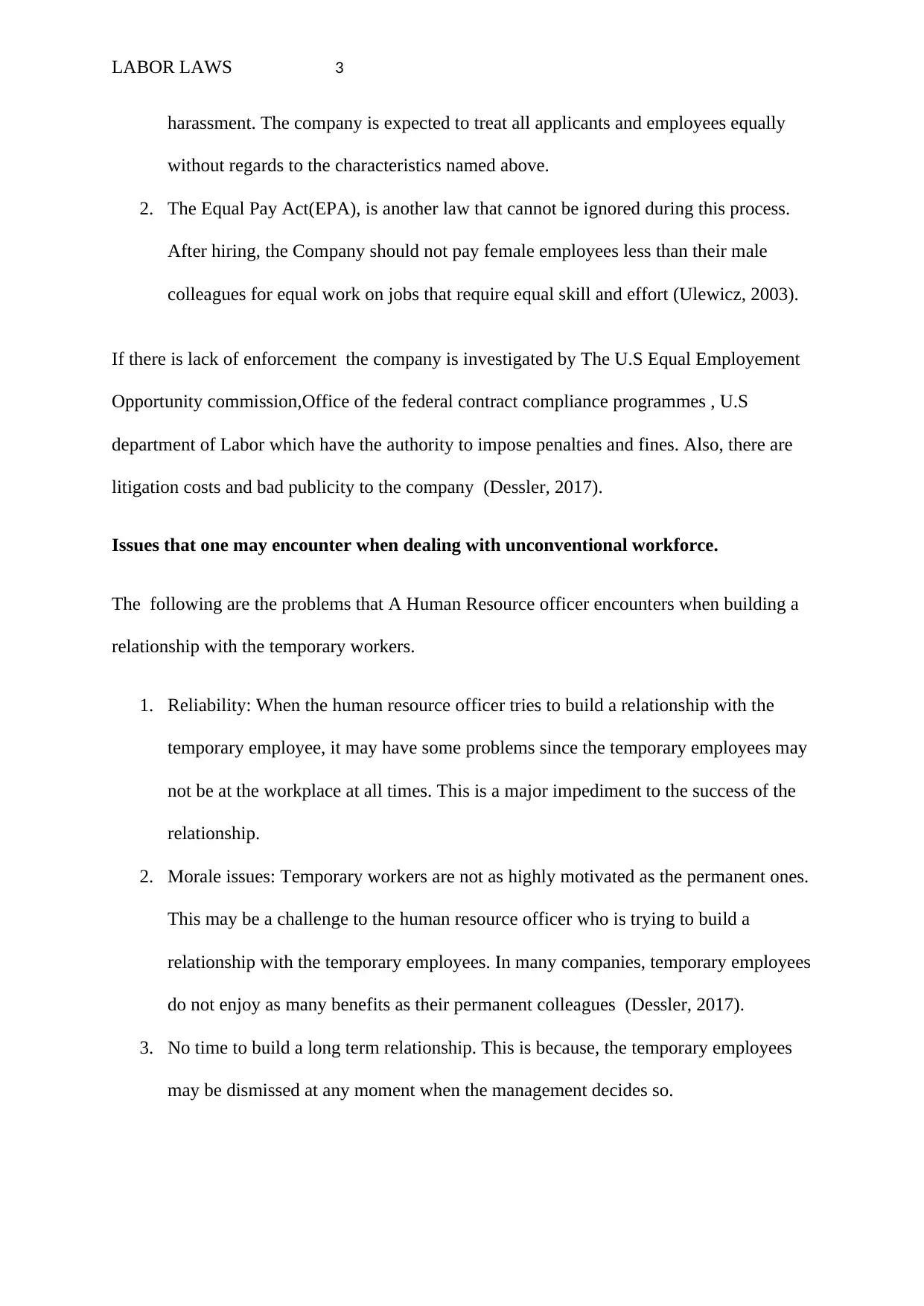
LABOR LAWS 3
harassment. The company is expected to treat all applicants and employees equally
without regards to the characteristics named above.
2. The Equal Pay Act(EPA), is another law that cannot be ignored during this process.
After hiring, the Company should not pay female employees less than their male
colleagues for equal work on jobs that require equal skill and effort (Ulewicz, 2003).
If there is lack of enforcement the company is investigated by The U.S Equal Employement
Opportunity commission,Office of the federal contract compliance programmes , U.S
department of Labor which have the authority to impose penalties and fines. Also, there are
litigation costs and bad publicity to the company (Dessler, 2017).
Issues that one may encounter when dealing with unconventional workforce.
The following are the problems that A Human Resource officer encounters when building a
relationship with the temporary workers.
1. Reliability: When the human resource officer tries to build a relationship with the
temporary employee, it may have some problems since the temporary employees may
not be at the workplace at all times. This is a major impediment to the success of the
relationship.
2. Morale issues: Temporary workers are not as highly motivated as the permanent ones.
This may be a challenge to the human resource officer who is trying to build a
relationship with the temporary employees. In many companies, temporary employees
do not enjoy as many benefits as their permanent colleagues (Dessler, 2017).
3. No time to build a long term relationship. This is because, the temporary employees
may be dismissed at any moment when the management decides so.
harassment. The company is expected to treat all applicants and employees equally
without regards to the characteristics named above.
2. The Equal Pay Act(EPA), is another law that cannot be ignored during this process.
After hiring, the Company should not pay female employees less than their male
colleagues for equal work on jobs that require equal skill and effort (Ulewicz, 2003).
If there is lack of enforcement the company is investigated by The U.S Equal Employement
Opportunity commission,Office of the federal contract compliance programmes , U.S
department of Labor which have the authority to impose penalties and fines. Also, there are
litigation costs and bad publicity to the company (Dessler, 2017).
Issues that one may encounter when dealing with unconventional workforce.
The following are the problems that A Human Resource officer encounters when building a
relationship with the temporary workers.
1. Reliability: When the human resource officer tries to build a relationship with the
temporary employee, it may have some problems since the temporary employees may
not be at the workplace at all times. This is a major impediment to the success of the
relationship.
2. Morale issues: Temporary workers are not as highly motivated as the permanent ones.
This may be a challenge to the human resource officer who is trying to build a
relationship with the temporary employees. In many companies, temporary employees
do not enjoy as many benefits as their permanent colleagues (Dessler, 2017).
3. No time to build a long term relationship. This is because, the temporary employees
may be dismissed at any moment when the management decides so.
⊘ This is a preview!⊘
Do you want full access?
Subscribe today to unlock all pages.

Trusted by 1+ million students worldwide
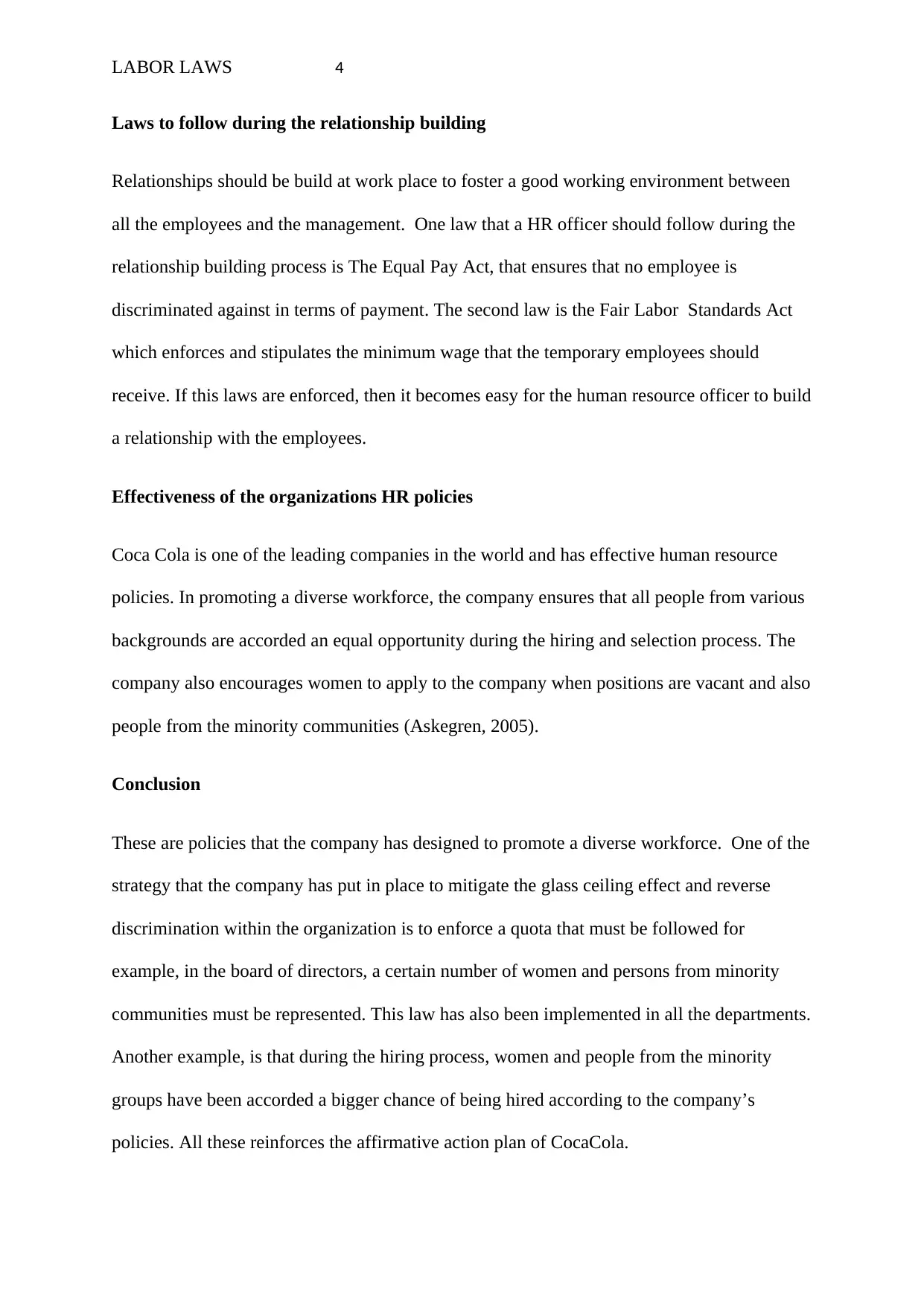
LABOR LAWS 4
Laws to follow during the relationship building
Relationships should be build at work place to foster a good working environment between
all the employees and the management. One law that a HR officer should follow during the
relationship building process is The Equal Pay Act, that ensures that no employee is
discriminated against in terms of payment. The second law is the Fair Labor Standards Act
which enforces and stipulates the minimum wage that the temporary employees should
receive. If this laws are enforced, then it becomes easy for the human resource officer to build
a relationship with the employees.
Effectiveness of the organizations HR policies
Coca Cola is one of the leading companies in the world and has effective human resource
policies. In promoting a diverse workforce, the company ensures that all people from various
backgrounds are accorded an equal opportunity during the hiring and selection process. The
company also encourages women to apply to the company when positions are vacant and also
people from the minority communities (Askegren, 2005).
Conclusion
These are policies that the company has designed to promote a diverse workforce. One of the
strategy that the company has put in place to mitigate the glass ceiling effect and reverse
discrimination within the organization is to enforce a quota that must be followed for
example, in the board of directors, a certain number of women and persons from minority
communities must be represented. This law has also been implemented in all the departments.
Another example, is that during the hiring process, women and people from the minority
groups have been accorded a bigger chance of being hired according to the company’s
policies. All these reinforces the affirmative action plan of CocaCola.
Laws to follow during the relationship building
Relationships should be build at work place to foster a good working environment between
all the employees and the management. One law that a HR officer should follow during the
relationship building process is The Equal Pay Act, that ensures that no employee is
discriminated against in terms of payment. The second law is the Fair Labor Standards Act
which enforces and stipulates the minimum wage that the temporary employees should
receive. If this laws are enforced, then it becomes easy for the human resource officer to build
a relationship with the employees.
Effectiveness of the organizations HR policies
Coca Cola is one of the leading companies in the world and has effective human resource
policies. In promoting a diverse workforce, the company ensures that all people from various
backgrounds are accorded an equal opportunity during the hiring and selection process. The
company also encourages women to apply to the company when positions are vacant and also
people from the minority communities (Askegren, 2005).
Conclusion
These are policies that the company has designed to promote a diverse workforce. One of the
strategy that the company has put in place to mitigate the glass ceiling effect and reverse
discrimination within the organization is to enforce a quota that must be followed for
example, in the board of directors, a certain number of women and persons from minority
communities must be represented. This law has also been implemented in all the departments.
Another example, is that during the hiring process, women and people from the minority
groups have been accorded a bigger chance of being hired according to the company’s
policies. All these reinforces the affirmative action plan of CocaCola.
Paraphrase This Document
Need a fresh take? Get an instant paraphrase of this document with our AI Paraphraser
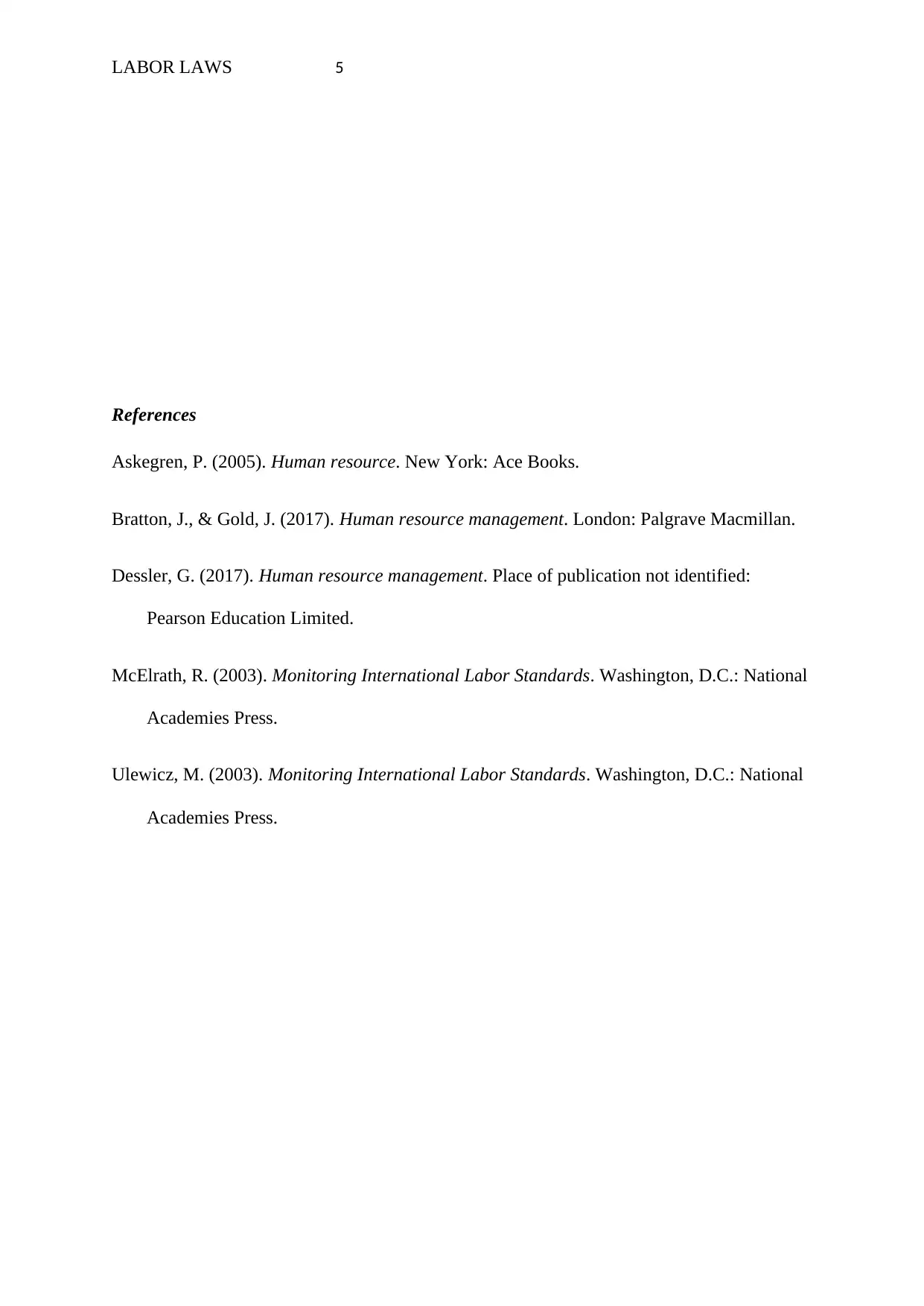
LABOR LAWS 5
References
Askegren, P. (2005). Human resource. New York: Ace Books.
Bratton, J., & Gold, J. (2017). Human resource management. London: Palgrave Macmillan.
Dessler, G. (2017). Human resource management. Place of publication not identified:
Pearson Education Limited.
McElrath, R. (2003). Monitoring International Labor Standards. Washington, D.C.: National
Academies Press.
Ulewicz, M. (2003). Monitoring International Labor Standards. Washington, D.C.: National
Academies Press.
References
Askegren, P. (2005). Human resource. New York: Ace Books.
Bratton, J., & Gold, J. (2017). Human resource management. London: Palgrave Macmillan.
Dessler, G. (2017). Human resource management. Place of publication not identified:
Pearson Education Limited.
McElrath, R. (2003). Monitoring International Labor Standards. Washington, D.C.: National
Academies Press.
Ulewicz, M. (2003). Monitoring International Labor Standards. Washington, D.C.: National
Academies Press.
1 out of 5
Your All-in-One AI-Powered Toolkit for Academic Success.
+13062052269
info@desklib.com
Available 24*7 on WhatsApp / Email
![[object Object]](/_next/static/media/star-bottom.7253800d.svg)
Unlock your academic potential
Copyright © 2020–2025 A2Z Services. All Rights Reserved. Developed and managed by ZUCOL.


